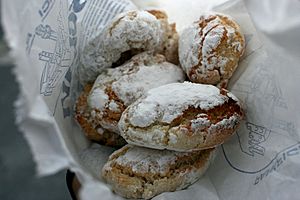Ricciarelli facts for kids

Ricciarelli from Siena
|
|
| Type | Biscuit |
|---|---|
| Place of origin | Italy |
| Region or state | Siena, Tuscany |
| Main ingredients | Almonds, sugar, honey, egg whites |
Ricciarelli are yummy traditional Italian biscuits. They are a special kind of macaroon cookie. These sweet treats first came from Siena, a city in Italy, way back in the 14th century.
Ricciarelli are one of Siena's most famous sweets. Other popular treats from Siena include panforte, cenci, and cavallucci.
The Story Behind Ricciarelli
There's a cool legend about how Ricciarelli got started. It's said that a person named Ricciardetto della Gherardesca brought them to Italy. He came back from the Crusades (a series of religious wars) and had these new biscuits.
He supposedly said they "curled like the Sultan's slippers." Even though the cookies today don't really curl, the story is still fun!
In the old days, during medieval times, these cookies had different names. People called them marzapanetti alla senese or morzelletti. They only got the name ricciarelli much later, in the 1800s.
Some people think the name ricciarelli comes from the Italian word rìccio. This word means 'hedgehog'. Maybe the first cookies looked a bit like a hedgehog, especially if they had sliced almonds on them!
How Ricciarelli Are Made
Today, Ricciarelli cookies are made with a base of almonds. They also include sugar, honey, and egg whites.
Here's how they are traditionally made:
- First, the almonds are ground up using a special machine.
- Then, the cookie mix is shaped into small oval or diamond shapes. Each cookie is usually about 20 grams (less than an ounce).
- These shaped cookies are left to sit for two days before they are baked. This helps them get the right texture.
- After baking, they cool down for about 15 minutes. This stops them from breaking when moved.
- Sometimes, they are baked on rice paper. This paper is trimmed to fit the cookie's shape after it cools.
- The cookies usually have a rough, cracked surface. This is often lightly dusted with confectioner's sugar.
- You might also find them covered in dark chocolate!
Ricciarelli are often eaten during Christmas celebrations. People usually enjoy them with a sweet dessert wine. Two popular wines to pair them with are Vin Santo or Moscadello di Montalcino.
When you buy packaged Ricciarelli in stores, they often come wrapped in blue paper. This paper usually has a picture of two winged horses. These horses are from the Etruscan Archeological Museum in Volterra, Italy.
See also
 In Spanish: Ricciarelli para niños
In Spanish: Ricciarelli para niños

